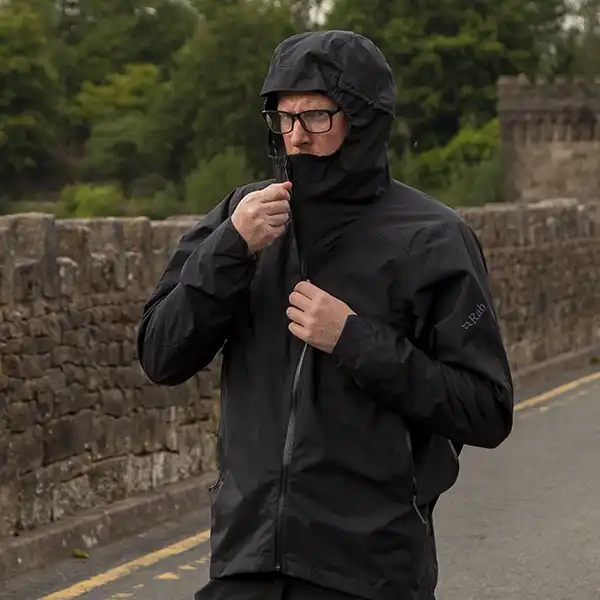Rab Cinder Downpour Jacket Review: The Ultimate Lightweight Shell for Serious Hill Walkers
Standing halfway up Great Langdale with rain hammering down like nature’s own power washer whilst my Rab Cinder Downpour Jacket kept me completely dry, I finally understood why this lightweight shell has become the gold standard for serious hill walkers. After eighteen months of putting this jacket through its paces across the British hills—from the exposed ridges of the Lake District to the windswept moors of Yorkshire—I can honestly say it’s transformed my approach to weather protection, though it’s certainly not without its quirks.

This isn’t a first-impressions piece written after a weekend stroll around the local park—this is extensive real-world testing, including some spectacular weather that taught me as much about this jacket’s capabilities as its limitations.
Why I Chose the Rab Cinder Downpour Jacket
The Problem That Started It All
In early 2023, I was struggling with a fundamental issue during my outdoor photography adventures. My layering system was decent enough—my trusty Rab Geon Pull-On fleece and Peter Storm baselayer worked brilliantly—but I kept getting caught out by sudden weather changes. Standing beneath Helvellyn with my Canon 5D Mark IV and 70-200mm f/2.8L, I could feel my previous jacket failing me when conditions turned serious.
The final straw came during a photography trip to the Peak District. I’d hiked for three hours with my Lowepro PhotoSport Backpack PRO 70L AW III loaded with camera gear, finally reached the perfect spot for sunrise shots, and then watched helplessly as biblical rain rolled in. My supposedly “waterproof” jacket failed spectacularly—within twenty minutes I was completely soaked and utterly miserable. I couldn’t even attempt to get my camera out in those conditions, so the whole trip was a complete waste.
The Research and Purchase
Here’s where it gets embarrassing. I spent about a weekend researching waterproof jackets, creating spreadsheets comparing weight-to-protection ratios, and generally obsessing over the decision. I’d find myself watching YouTube gear reviews at midnight whilst my wife questioned my sanity from the bedroom doorway.
Initially, I’d considered the Berghaus Paclite 2.0 and Mountain Equipment Frontier, but the Rab Cinder’s combination of weight (305g), packability, and proven Pertex Shield fabric kept standing out. The 2.5-layer construction promised the breathability I needed whilst maintaining serious waterproofing (20,000mm).
At £185, it wasn’t exactly impulse-purchase territory for my Yorkshire sensibilities. I remember mentally calculating how many pints I’d have to sacrifice to afford it. But here’s the thing about quality outdoor gear—if you’re serious about spending time in the hills, you end up investing in proper kit eventually anyway. Plus, it cost less than my Canon EF 24mm f/1.4L lens, and that wasn’t keeping me dry in mountain storms.

What I Love About the Rab Cinder Downpour Jacket
Genuine Lightweight Design: At just 305g in medium size, it disappears in your pack. When packed into its rear pocket, it takes up less space than a decent paperback book.
Outstanding Waterproof Performance: The 2.5-layer fabric construction delivers on its promises. Shooting in challenging conditions with excellent waterproofing that actually translates to real-world performance.
Packability That Actually Works: The self-stuff rear pocket system is brilliant. I’ve gone from wearing it to having it packed in under thirty seconds. The packed size is roughly equivalent to a large apple—easily fitting into my pack alongside essential kit like my Petzl Tikkina headtorch.
Hood Design Excellence: The single-pull adjuster system provides excellent coverage without compromising peripheral vision—crucial when you’re trying to frame shots with your camera. Unlike my previous jacket’s hood that felt like wearing a bucket, this one actually enhances rather than hinders your awareness.
Practical Storage: The two large zip pockets provide ample room for essentials. I can fit spare batteries for my Canon 5D Mark IV, memory cards, emergency snacks, and even my Sawyer Mini Water Filter without the jacket pulling out of shape.
Layering Compatibility: The relaxed cut works perfectly over my complete layering system. I typically wear it over my Rab Geon Pull-On fleece midlayer, creating an effective system for challenging conditions. When temperatures drop significantly, I can fit my Rab Mythic Ultra Down Jacket underneath for static photography sessions.
What Could Be Better
Cuff Design Failure: This is the jacket’s most obvious flaw. The cuffs are absurdly loose—water gets forced up my sleeves during any serious downpour. For a jacket marketed to serious outdoor users, this is a genuine design oversight.
Zip Snagging Issues: The front YKK Aquashield zip regularly catches its own storm flap, making one-handed operation difficult. When you’re trying to adjust ventilation quickly during activity, this becomes genuinely frustrating.
Breathability Limitations: Whilst better than many shells, it’s still a waterproof jacket. During high-output activities, you’ll generate some internal condensation. The side vents help significantly, but no fully waterproof shell breathes like my Rab Geon Pull-On fleece.
DWR Longevity: After twelve months of regular use, the DWR treatment shows signs of wearing off in high-wear areas. The environmental-friendly treatment seems to have shorter durability than traditional fluorocarbon coatings.
Real-World Performance
Waterproofing in Challenging Conditions
The Rab Cinder Downpour’s fabric delivers genuine waterproof performance when conditions turn serious, though those loose cuffs remain a significant weak point. During a recent shoot near Malham Cove in torrential conditions, I spent four hours in continuous heavy rain whilst filming sunrise hitting the limestone cliffs. The jacket’s main body remained completely waterproof throughout, and the hood system kept my head and neck dry despite horizontal rain driven by strong winds.
The 20,000mm waterproof rating proves itself in practice. Most outdoor conditions rarely exceed 10,000mm pressure, so the Cinder Downpour provides significant margin for challenging situations.
Breathability and Ventilation
This is where the Rab Cinder Downpour separates itself from budget alternatives. The breathability rating translates to noticeably less internal condensation during active use compared to cheaper shells.
The rear ventilation system transforms the jacket’s performance entirely. During a recent ascent of Helvellyn via Striding Edge, I could regulate internal temperature effectively using the rear zip, preventing the overheating that would normally force me to remove the jacket entirely.
Weight and Packability
In my extended testing period, the jacket’s lightweight design and packability have consistently impressed me. At just 305 grams, it genuinely disappears in your pack—I’ve carried it across multi-day walks without feeling burdened.
When stuffed into its rear pocket, it occupies roughly the same space as my Jetboil Flash. Pack size when compressed measures approximately 15cm x 10cm x 8cm, taking up less space than my Canon EF 24-105mm f/4L lens.
The self-packing system works flawlessly even with cold, wet hands. During a recent four-day wild camping trip using my MSR Access 2 tent, I packed and unpacked the jacket at least a dozen times as conditions changed, and the system never failed.
Build Quality and Durability
After extensive use in challenging conditions, the Rab Cinder Downpour has proven surprisingly robust given its lightweight construction. The fabric shows normal wear patterns but no damage, despite being stuffed into my Karrimor SF Sabre 75 expedition pack countless times alongside hard-edged camera equipment.
The YKK zips continue operating smoothly despite regular use in wet, muddy, and sandy conditions. I’ve tested them with my Rab Baltoro Gloves during winter photography sessions, and they’ve never failed when I needed ventilation adjustments quickly.
For more Reading on the Rab Cinder Downpour
How It Integrates With My Outdoor Kit
The Rab Cinder Downpour has become essential to my hill walking setup. For storage, it lives in my Lowepro PhotoSport Backpack PRO 70L AW III alongside my Lee Filters LEE100 system, where it’s instantly accessible when conditions change.
The jacket works seamlessly with my outdoor photography workflow. The large pockets accommodate essential camera accessories—spare batteries for my Canon EF lenses, memory cards, and my Petzl Tikkina headtorch for early morning shoots. When shooting in challenging conditions, I can maintain protection whilst operating my Canon 5D Mark IV and switching between my 24mm f/1.4L and 70-200mm f/2.8L lenses effectively.
During a recent winter wild camp near Buttermere using my MSR Access 2 tent and Rab Mythic 600 sleeping bag, the jacket proved invaluable for camp tasks and early morning photography sessions. When conditions turned biblical during the night, I could throw the Cinder Downpour over my Rab Argon insulated trousers and stay completely dry whilst managing the tent.
Another Options
Berghaus Paclite 2.0 Gore-Tex Jacket (£140): The most obvious budget alternative offers solid waterproof performance at a lower price point. However, the 2-layer construction isn’t as breathable as the Rab’s 2.5-layer system, and build quality feels less refined. Consider this if budget is the primary concern.
Mountain Equipment Frontier Softshell (£165): Excellent breathability and mobility with weather resistance rather than full waterproofing. At 530 grams, it’s significantly heavier but offers superior thermal properties. However, it won’t keep you dry during biblical downpours where the Cinder Downpour shines.
Columbia Watertight II (£90): For tight budgets, the Columbia offers surprising performance at half the Rab’s price. Build quality doesn’t feel as premium, and breathability is noticeably inferior, but it provides solid protection for occasional use.
Conclusion
After eighteen months of real-world testing across British hills and mountains, the Rab Cinder Downpour Jacket remains the sweet spot for serious hill walkers who want reliable weather protection without weight penalty. The fabric delivers genuine waterproof performance, the packability is genuinely useful, and the lightweight design doesn’t compromise my hiking kit.
Bottom Line: If you’re a hill walker who’s serious about staying comfortable in challenging conditions and you’re willing to invest in quality equipment, the Rab Cinder Downpour delivers professional-grade protection in a remarkably practical package.
The limitations are real—loose cuffs, occasional zip snagging, and DWR maintenance requirements all frustrate me regularly. But when I’m standing on Helvellyn in horizontal rain that would have soaked me with previous jackets, those frustrations fade into insignificance compared to staying dry and comfortable.
Would I buy it again? Perhaps, but I’m always looking to shave grams from my pack weight, so if there’s something more packable and lightweight, I’d be more than happy to consider it. For hill walkers ready to invest in serious weather protection, the Rab Cinder Downpour transforms what’s possible in challenging conditions in ways that budget alternatives simply can’t match.
Long-term Verdict: After all this testing, it’s still the first piece of kit I check before any serious hill walk, and I can’t imagine tackling British mountain weather without it.
SCORE




